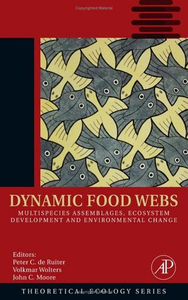How do complex food webs persist in nature?
Dell, Anthony I., Kokkoris, Giorgos D., Banašek -Richter, Carolin, Bersier, Louis-Félix, Dunne, Jennifer A., Kondoh, Michio, Romanuk, Tamara N., and Martinez, Neo D. (2005) How do complex food webs persist in nature? In: de Ruiter, Peter, Wolters, Volkmar, and John, Moore, (eds.) Dynamic Food Webs: : multispecies assemblages, ecosystem development, and environmental change. Theoretical Ecology Series, 3 . Academic Press, London, UK, pp. 425-436.
|
PDF (Published Version)
Restricted to Repository staff only |
||
![[img]](https://researchonline.jcu.edu.au/10421/2.hassmallThumbnailVersion/10421_Dell_et_al_2005_cover.jpg)
|
Image (JPEG) (cover)
Download (44kB) |
Abstract
Natural ecological communities are composed of a large and often indeterminate number of taxonomic species that trophically interact in myriad ways. Food webs describe the networks of these relations. While the population dynamics of individual species are often highly variable (Bjornstad and Grenfell, 2001), the overall structure of the trophic relations of the community, its food web, is comparatively more stable as they exhibit remarkably consistent patterns (Martinez, 1993b, 1994; Warren, 1994; Camacho et al., 2002a; Garlaschelli et al., 2003) and follow surprisingly consistent rules (Williams and Martinez, 2000; Camacho et al., 2002b; Cattin et al., 2004). This consistency combined with population variability makes natural food webs both rather dynamically and structurally complex and also somewhat stable over ecological time. For the most part theory has been unable to explain these high levels of complexity in terms of diversity and number of trophic relations because these elements are traditionally thought to decrease stability (May, 1973) and population persistence (Brose et al., 2003; Williams and Martinez, 2004c) in modeled communities. This disparity between real patterns and those predicted by theory has been one of most pressing issues facing ecologists for the past few decades. If the mechanisms driving the trophic dynamics of natural communities are to be understood, this paradox needs to be resolved and a robust theoretical framework needs to be developed that adequately explains the persistence of complex food webs in a way that is consistent with high quality empirical data. Identification of the mechanisms or "devious strategies" (May, 1973) that permit the persistence of complex food webs would be a valuable discovery for community ecology and would resolve a major paradigm within the complexity-stability debate (Brose et al., 2003). This chapter broadly outlines the current state of the complexity-stability relationship in food webs, the different approaches used to examine this issue, our current understanding of the mechanisms that appear to stabilize complex natural food webs and highlights some for the most promising research directions for future focus.
| Item ID: | 10421 |
|---|---|
| Item Type: | Book Chapter (Research - B1) |
| ISBN: | 978-0-12-088458-2 |
| Additional Information: | Academic Press is an imprint of Elsevier |
| Date Deposited: | 12 Jul 2010 23:36 |
| Downloads: |
Total: 323 Last 12 Months: 5 |
| More Statistics |



